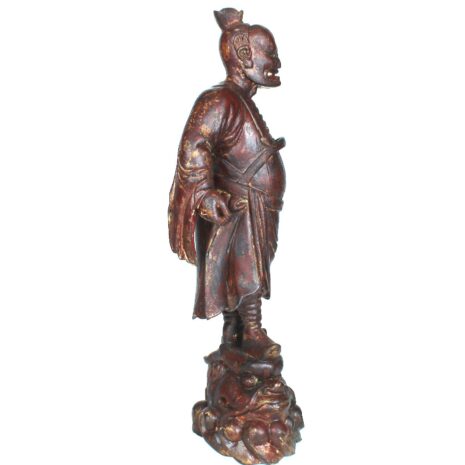Description
Initially linked to the Big Dipper in Chinese mythology, Wen Chang is worshipped in the 3rd and 8th months as the God of several spheres: Literature, Books and Writing, Education, Learning and Examinations and is the patron saint of scholars. As one of the revered Taoist-deities, hero and one of the house-gods closely associated with Confucianism, he is syncretic – a blend of many religious traditions. He is associated with the parable of a carp struggling to swim upstream who morphs into a dragon and reaches the Dragon Gate atop a waterfall, a metaphor for the rigors needed by scholars to pass imperial civil service examinations that leads to an influential post, security and wealth in the state bureaucracy. Excellence in scholarship was considered to be the main determinate of one’s rank and social status in Confucian society. Dragons, one of China’s most propitious, beautiful and friendly mythical-animals are the greatest divine creatures on earth, the ultimate symbols of the forces of Nature that bring abundance, prosperity, and good fortune. Wen Chang may also be shown holding a writing brush or rice measure with one leg kicking back, derived from the combination of Chinese characters making up his name that means “demon,” “dipper or bushel measure,” and “kick.” Temples dedicated to him are in most Chinese cities and statues of him were proudly displayed in scholars studies and desks by a wide range of literary persons including students, government officials, writers and calligraphers.
Additional information
| Weight | 7 lbs |
|---|---|
| Dimensions | 18 × 12 × 6 in |
| Place of Origin | China |
| Period | Antique, Qing Dynasty |
| Date | 18th century |
| Materials and Technique | Wood |
| Dimensions (inches) | Ht:15.5” W: 5.5” D: 4.5” |
| Dimensions (metric) | Ht: 39.37cm W: 13.97cm D: 11.43cm |
| Weight | 1 lb 9oz |
| Condition | Excellent, fine patina demonstrating age and use |
| Item Number | 16615PBRK |
| Shipping Box Size |












